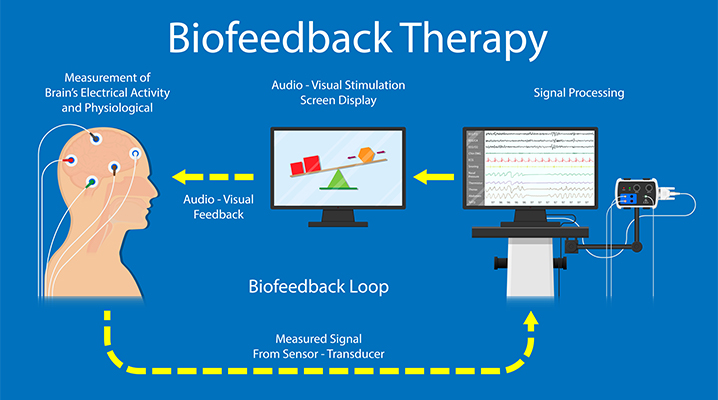 You are tired.
You are tired.
You have been to one therapist, then another. Another doctor’s waiting room for 45 minutes, see the doctor, how are the symptoms, and 5 minutes scheduling your next visit.
You are tired of the pills (and their side effects). You have done therapy, but here you are.
The worry, the memories, and the lack of focus are still here despite all your efforts.
Neurofeedback is gaining popularity in mental health circles (and with good reason) for its ability to help you understand your brain and make meaningful, long-term changes without using medication or “talking about it.”
This can be a big benefit if you have a significant trauma that haunts you (and you want to get better without talking about it), want to improve sleep, or have attention problems. Neurofeedback can give insights into the root causes of what is happening and help you make meaningful changes to your brain and your life.
It is extremely validating when clients hear how the brain contributes to challenges and if something can be done to improve this.
 Brian* had been diagnosed with ADHD when he was in elementary school.
Brian* had been diagnosed with ADHD when he was in elementary school.
He graduated high school but did not finish college (largely because of his executive-function challenges!). Brian has worked many entry-level jobs but is now in his mid-20s and is without developed career skills or a game plan.
Brian had stopped taking his ADHD medication in high school because he didn’t think he needed them. I assessed Brian with my QEEG Brain Map, which showed his brain to be in the detailed profile of an ADHD brain (an under-aroused brain in the brain’s executive system). This insight motivated Brian to restart, commit to the right medication, and work with his physician. Brian completed a vocational inventory that, when combined with his personality profile, gave him a sense of direction of where to go with his career.
Now that Brian’s brain is awake with the right medications, and training his brain with Neurofeedback, he is making plans for his career development, using a planning system that works for him. Brian is following through on his commitments, making educational choices to move from a dead-end job to a career. Brian is back in school and confident he can succeed… something he never thought he could do.
In his Neurofeedback training, he is learning to identify the calm, focused feeling he is trained for. As Brian generalizes this calm focus in his life, he is persisting in tasks he would have given up, making realistic plans and following through, and experiencing improved executive-function skills (task initiation, planning, organizing, etc.).
 So… what is Neurofeedback, and how does it come into play?
So… what is Neurofeedback, and how does it come into play?
It’s also called quantitative electroencephalogram (QEEG) biofeedback. I know: That is a mouthful – in English, please! Let me explain…
Neurofeedback is a safe, non-invasive, scientific-based approach to making lasting changes in the brain. I’ve used Neurofeedback to help my clients manage ADHD, anxiety, trauma, depression, and sleep.
When we do Neurofeedback, we’ll assess your current symptoms, lifestyle, medication, and goals. We’ll also measure your baseline functioning with a brief online neuropsychological test and capture your brain activity with a QEEG (more on that below).
Here’s what it looks like…
Neurofeedback can also be called QEEG-Biofeedback. The QEEG uses electrodes, amplifiers, and a computer to decipher the signals of how your brain is firing.
Based on years of research, we know we can help optimize your brain. For example, individuals with ADHD often benefit from training their brains to reinforce calm/focused states.
The great news is that these changes can become lasting with adequate intensity, frequency, and duration. Ideally, Neurofeedback training occurs with two sessions per week for the first 20 Neurofeedback training sessions. However, the brain can respond more quickly, and you may see results with increased frequency of training (three or more times per week). The training frequency is something to consider if you are planning long absences while we are training (e.g., two weeks or more vacations). If so, we may consider home Neurofeedback options or if this is the right time to start Neurofeedback.
Some valuable information this provides is if your brain is over-aroused or under-aroused, which can guide treatment targets. Clients learn how their brain fires, bringing understanding to themselves and their inner experiences.

What is the initial QEEG like? What is Neurofeedback training like?
During the first QEEG (which will likely be in the morning – due to time-of-day effects on the brain), you will shower before you come in and not style your hair (hair products can distort the electrical signal).
You will come into my office and sit down across from a computer monitor. A technician or I will clean your ears and the selected areas of your scalp with rubbing alcohol and then a gritty paste (NuPrep) to remove dead skin and any oil that may be around. Then electrode paste is applied to electrodes and placed on your ears and scalp.
I will check that we have a good signal and then ask you to grit your teeth, blink your eyes, and make other movements to see how it looks on the QEEG. Once that is squared away, we will start the recording.
During the recording, I may ask you to read, listen, and do a math problem in your head, which allows us to see how your brain responds to tasks. I will also record your brain with both eyes open and both eyes closed. When we finish, I will help you clean the electrode paste off your ears and scalp, and we will schedule our feedback meeting, usually 1-2 weeks later.
During the feedback meeting, we will review the results of the QEEG. One thing that I like to look for is recognizing some of the ways that your brain is working well, in addition to some ways that we can help improve your brain.
Reviewing the QEEG often leads to further discussion of ways that we can optimize your brain and your health. This experience can often be validating for individuals to see feedback “that it is not just all in my head.” We will also review the suggested training protocol and discuss how we might measure progress together.
 Typical Neurofeedback session…
Typical Neurofeedback session…
A typical Neurofeedback session would involve you coming to the office and getting hooked up to the electrodes in a similar manner discussed above.
Based on the training protocol, we might train with eyes open or eyes closed. During eyes-open training, you will likely watch a lecture. (I like to have individuals training to practice doing a task-relevant behavior. For example, if you are training to improve your attention, maintaining attention during a lecture is a task-relevant behavior.)
You will get feedback from the computer when your brain is doing what you want and when it goes out of the desired training parameters. For example, when your brain is not firing as we want it to, the computer screen will get blurry and smaller (which is not preferred by brains). In the eyes closed condition, you will listen to music. You will get feedback from the sound getting quieter when your brain is not firing as the training suggests.
The power of Neurofeedback is that your brain “learns” to be in these desired states. This ties into one of the laws of neuroscience – Hebb’s postulate: “neurons that fire together, wire together.”
With Neurofeedback, we are tapping into one of the brain’s superpowers – its ability to learn.
Putting it all together…
Amanda* came to me after graduating from college.
She didn’t have a direct path toward a career.
She managed to get through college based on some very supportive professors but had consistently struggled with executive-function problems (task initiation, task completion, working memory, time-blindness).
We did a QEEG Brain Map and found that her brain fit the typical profile of an individual with ADHD. Amanda also reported sleeping problems (reflected on the QEEG), and I helped Amanda find a sleep doctor.
Amanda was subsequently diagnosed with a primary sleep disorder, and her executive-function challenges dramatically improved. In our work together, Amanda identified some career directions, and Amanda is now in the process of pursuing a professional certification. She can now make and follow through on her professional goals.
How much is your underperforming brain costing you?
The best news about Neurofeedback is that it produces lasting results.
But like most things worth having, it’s not a quick and easy fix. It’s not uncommon to need 40-60 visits to complete the training.
However, as already mentioned, there are many advantages: lasting changes, minimal to no side effects, and finally gaining traction on the suffering that has been there for far too long.
Ready for lasting change?
When you’re ready to wake up to a new day and take advantage of what Neurofeedback offers, please call us at (832) 831-0178 for a free consultation.
*Names and stories are composite narratives and do not reflect actual clients.

